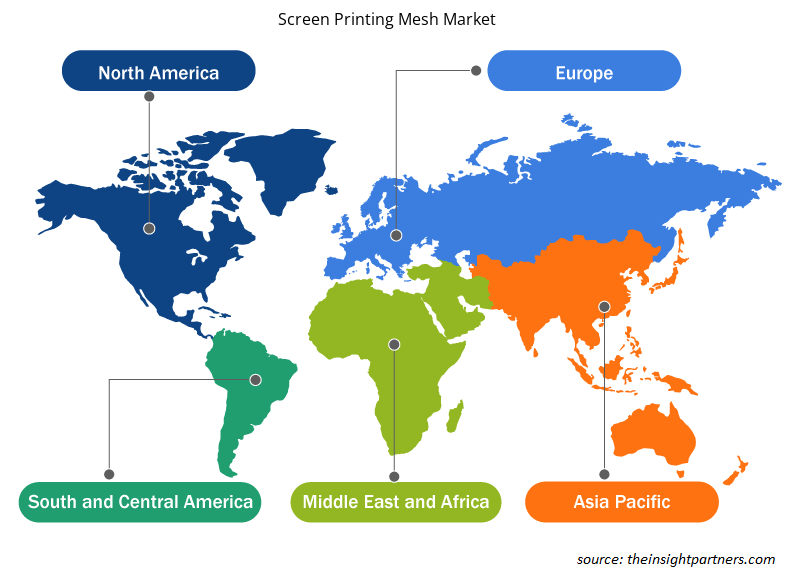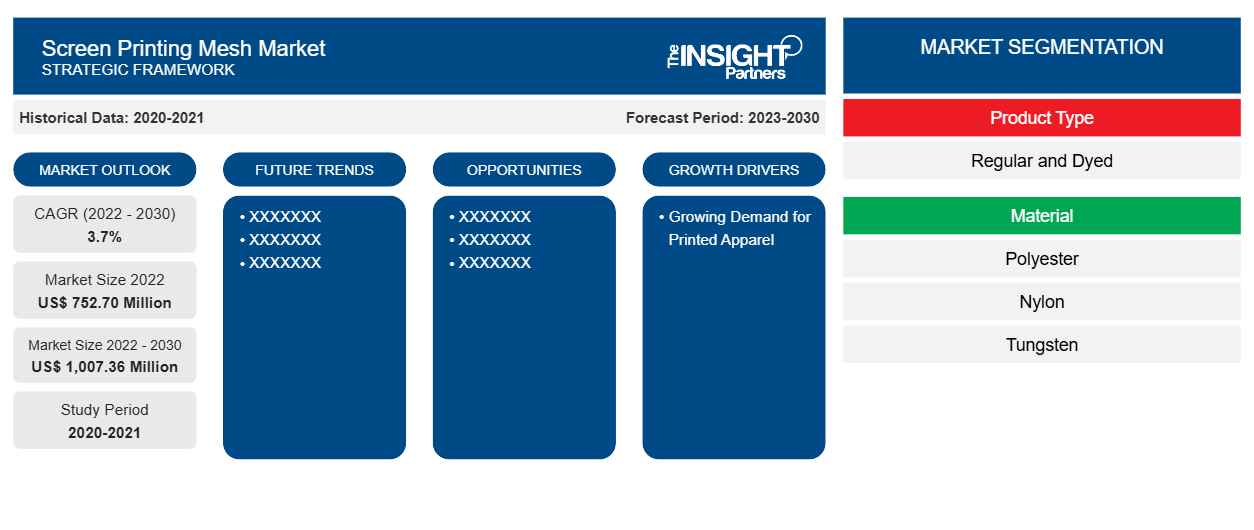[تقرير بحثي] من المتوقع أن ينمو حجم سوق شبكة الطباعة على الشاشة من 752.70 مليون دولار أمريكي في عام 2022 إلى 1،007.36 مليون دولار أمريكي بحلول عام 2030؛ ومن المتوقع أن يسجل معدل نمو سنوي مركب بنسبة 3.7٪ من عام 2022 إلى عام 2030.CAGR of 3.7% from 2022 to 2030.
رؤى السوق ووجهة نظر المحلل:
تشير شبكة الطباعة على الشاشة إلى القماش المنسوج أو المادة التي يتم شدها بإحكام فوق إطار لإنشاء شاشة للطباعة على الشاشة. تأتي شبكة الطباعة على الشاشة بأعداد مختلفة من الشبكات. توفر شبكات الطباعة على الشاشة بأحجام شبكية مختلفة مزايا محددة أثناء عملية الطباعة على الشاشة. وهي مصنوعة من مواد مثل النايلون والبوليستر والفولاذ المقاوم للصدأ والتنغستن وغيرها. شبكة الطباعة على الشاشة المصنوعة من البوليستر هي مادة مستخدمة على نطاق واسع بسبب تنوعها ومتانتها الاستثنائية. تُستخدم شبكات الطباعة على الشاشة في المنسوجات والإلكترونيات والكهرباء والزجاج والسيراميك والعديد من الصناعات الأخرى. في صناعة الإلكترونيات والكهرباء، تُستخدم شبكة الطباعة على الشاشة للطباعة على مجموعة متنوعة من الركائز، مثل لوحات الدوائر والألواح الشمسية والدوائر المرنة والشاشات. كان هناك طلب متزايد على الملابس الشخصية والمخصصة، حيث يبحث المستهلكون عن عناصر فريدة ومخصصة تعكس أسلوبهم الشخصي. هذا العامل يدفع بشكل كبير نمو سوق شبكة الطباعة على الشاشة العالمية.electricals, glass, ceramics, and many other industries. In the electronics & electricals industry, screen printing mesh is used to print on a variety of substrates, such as circuit boards, solar panels, flexible circuits, and displays. There has been a growing demand for personalized and customized clothing, with consumers seeking unique and individualized items that reflect their personal style. This factor is significantly driving the global
محركات النمو والتحديات:
إن الاتجاه المتزايد للملابس المطبوعة يدفع الطلب على شبكة الطباعة بالشاشة في صناعة الملابس. في السنوات الأخيرة، كان هناك اتجاه متزايد نحو الملابس المطبوعة، حيث يبحث المستهلكون عن عناصر فريدة ومخصصة تعكس أسلوبهم. وقد دفع هذا الاتجاه الطلب على شبكة الطباعة بالشاشة في صناعة الملابس، حيث يسمح بالطباعة عالية الجودة والدقيقة للتصاميم المخصصة على مجموعة واسعة من الأقمشة والمواد. علاوة على ذلك، أصبحت المنتجات الترويجية تحظى بشعبية متزايدة حيث تسعى الشركات إلى طرق فعالة من حيث التكلفة للترويج لعلامتها التجارية. تعد شبكة الطباعة بالشاشة مكونًا رئيسيًا في إنشاء عناصر ترويجية عالية الجودة وجذابة للنظر. تستخدم العديد من الشركات والمؤسسات عناصر مطبوعة مخصصة، مثل القمصان والحقائب والقبعات، للترويج لعلامتها التجارية أو رسالتها. تسمح شبكة الطباعة بالشاشة بطباعة عالية الجودة وفعالة من حيث التكلفة لهذه المنتجات الترويجية بكميات كبيرة. مع تحول المزيد من الشركات إلى المنتجات الترويجية كاستراتيجية تسويقية، سيستمر الطلب على شبكة الطباعة بالشاشة في الزيادة. ومع ذلك، قد تشكل التطورات التكنولوجية في صناعة الطباعة تحديًا لمزيد من التوسع في سوق شبكة الطباعة بالشاشة على الرغم من إمكانات نموها. مع استمرار تحسن تقنيات الطباعة الرقمية، فإنها تقدم بديلاً عمليًا لطباعة الشاشة الشبكية للعديد من التطبيقات. تتيح الطباعة الرقمية أوقات استجابة أسرع ومرونة أكبر في التصميم والقدرة على الطباعة على مجموعة أوسع من المواد. يعيق هذا العامل الطلب على طباعة الشاشة الشبكية.
قم بتخصيص هذا التقرير ليناسب متطلباتك
ستحصل على تخصيص لأي تقرير - مجانًا - بما في ذلك أجزاء من هذا التقرير، أو تحليل على مستوى الدولة، وحزمة بيانات Excel، بالإضافة إلى الاستفادة من العروض والخصومات الرائعة للشركات الناشئة والجامعات
-
احصل على أهم اتجاهات السوق الرئيسية لهذا التقرير.ستتضمن هذه العينة المجانية تحليلاً للبيانات، بدءًا من اتجاهات السوق وحتى التقديرات والتوقعات.
تقسيم التقرير ونطاقه:
يتم تقسيم "سوق شبكة الطباعة على الشاشة العالمية" على أساس نوع المنتج والمادة والتطبيق. بناءً على نوع المنتج، يتم تقسيم سوق شبكة الطباعة على الشاشة إلى عادي ومصبوغ. بناءً على المادة، يتم تقسيم سوق شبكة الطباعة على الشاشة إلى البوليستر والنايلون والتنغستن والفولاذ المقاوم للصدأ وغيرها. بناءً على التطبيق، يتم تقسيم سوق شبكة الطباعة على الشاشة إلى المنسوجات والإلكترونيات والكهرباء والزجاج والسيراميك وغيرها. جغرافيًا، يتم تقسيم السوق إلى أمريكا الشمالية (الولايات المتحدة وكندا والمكسيك) وأوروبا (ألمانيا وفرنسا وإيطاليا والمملكة المتحدة وروسيا وبقية أوروبا) وآسيا والمحيط الهادئ (أستراليا والصين واليابان والهند وكوريا الجنوبية وبقية آسيا والمحيط الهادئ) والشرق الأوسط وأفريقيا (جنوب أفريقيا والمملكة العربية السعودية والإمارات العربية المتحدة وبقية الشرق الأوسط وأفريقيا) وأمريكا الجنوبية والوسطى (البرازيل والأرجنتين وبقية أمريكا الجنوبية والوسطى).
التحليل القطاعي:
بناءً على نوع المنتج، يتم تقسيم سوق شبكة الطباعة على الشاشة إلى عادي ومصبوغ. احتل القطاع العادي حصة سوقية أكبر في عام 2022. تعد شبكة الطباعة على الشاشة العادية مكونًا أساسيًا وغالبًا ما يتم التقليل من شأنه في إنتاج الطباعة والمنسوجات. تعمل شبكة الطباعة المصنوعة من مواد فاخرة مثل البوليستر والنايلون كلوحة متواضعة يتم التعبير عن التصميمات والأنماط المعقدة عليها. تكمن أهميتها في قدرتها على العمل كلوحة فارغة، مما يضمن بقاء ألوان وتفاصيل الطباعة النهائية وفية للعمل الفني الأصلي. بناءً على المادة، يتم تقسيم سوق شبكة الطباعة على الشاشة إلى البوليستر والنايلون والتنغستن والفولاذ المقاوم للصدأ وغيرها. كانت حصة سوق شبكة الطباعة على الشاشة لشريحة البوليستر ملحوظة في عام 2022. شبكة الطباعة على الشاشة المصنوعة من البوليستر هي مادة حيوية ومستخدمة على نطاق واسع في الطباعة على الشاشة، وهي موضع تقدير لتنوعها ومتانتها الاستثنائية. البوليستر، وهو بوليمر صناعي، يعمل كأساس لهذه الشبكة، وصفاته المتأصلة تجعله خيارًا مثاليًا لمجموعة واسعة من تطبيقات الطباعة. إحدى الخصائص البارزة لشبكة الطباعة على الشاشة المصنوعة من البوليستر هي قوتها ومرونتها. بناءً على التطبيق، يتم تقسيم سوق شبكة الطباعة على الشاشة إلى المنسوجات والإلكترونيات والكهرباء والزجاج والسيراميك وغيرها. كانت حصة سوق شبكة الطباعة على الشاشة لقطاع المنسوجات ملحوظة في عام 2022. أصبحت شبكة الطباعة على الشاشة أداة أساسية في صناعة المنسوجات، حيث تقدم مجموعة من الفوائد التي تجعلها خيارًا مثاليًا لطباعة التصميمات على الأقمشة. الشبكة مصنوعة من مادة عالية الجودة متينة ومرنة، مما يسمح بتمديدها على إطار دون فقدان شكلها أو سلامتها. هذا يجعل من السهل إنشاء سطح أملس ومتساوي للطباعة، مما يضمن التقاط كل تفاصيل التصميم بدقة. تتمثل إحدى المزايا الرئيسية لشبكة الطباعة على الشاشة في قدرتها على إنتاج تصميمات دقيقة ومفصلة، حتى على الأنماط أو الأقمشة المعقدة.
التحليل الإقليمي:
تم تقسيم سوق شبكة الطباعة على الشاشة إلى خمس مناطق رئيسية - أمريكا الشمالية وأوروبا وآسيا والمحيط الهادئ وأمريكا الجنوبية والوسطى والشرق الأوسط وأفريقيا. سيطرت منطقة آسيا والمحيط الهادئ على سوق شبكة الطباعة على الشاشة العالمية، وبلغت قيمة السوق الإقليمية حوالي 300 مليون دولار أمريكي في عام 2022. كما تعد أمريكا الشمالية مساهمًا رئيسيًا، حيث تمتلك جزءًا كبيرًا من حصة سوق شبكة الطباعة على الشاشة العالمية. ومن المتوقع أن يصل سوق أمريكا الشمالية إلى أكثر من 250 مليون دولار أمريكي في عام 2030. ومن المتوقع أن تسجل أوروبا معدل نمو سنوي مركب كبير يتجاوز 3٪ من عام 2022 إلى عام 2030. تم تقسيم سوق شبكة الطباعة على الشاشة في منطقة آسيا والمحيط الهادئ، حسب البلد، إلى أستراليا والصين والهند واليابان وكوريا الجنوبية وبقية منطقة آسيا والمحيط الهادئ. يتم دفع السوق بعوامل مثل الطلب المتزايد على الملابس المطبوعة والشعبية المتزايدة للمنتجات الترويجية. يرتبط الطلب على شبكة الطباعة على الشاشة في منطقة آسيا والمحيط الهادئ بالتصنيع ونمو إنتاج المنسوجات في المنطقة. في إطار أهداف التنمية المستدامة 2030، خطط بنك التنمية الآسيوي لبناء بنية تحتية مرنة، وتعزيز التصنيع الشامل والمستدام، وتشجيع الابتكار في منطقة آسيا والمحيط الهادئ. تعد منطقة آسيا والمحيط الهادئ المركز الرئيسي لصناعة المنسوجات. تتكون منطقة آسيا والمحيط الهادئ من دول مثل الصين والهند وبنجلاديش - المنتجين الرئيسيين للمنسوجات. إن ارتفاع عدد مصنعي المنسوجات في دول مثل الصين والهند وفيتنام وبنجلاديش يزيد من الحاجة إلى شبكة الطباعة على الشاشة.
تطورات الصناعة والفرص المستقبلية:
فيما يلي قائمة بالمبادرات المختلفة التي اتخذها اللاعبون الرئيسيون العاملون في سوق شبكة الطباعة على الشاشة:
- في مارس 2022، قامت شركة Sefar بتوسيع نطاق شبكة الطباعة الحريرية SEFAR PME. وقد تم عرض هذه الشبكات الجديدة في معرض FESPA 2022. أقمشة Sefar Open Mesh الجديدة هي SEFAR PME 59/150-48Y PW وSEFAR PME 75/190-40W/Y PW.
تأثير كوفيد-19:
أثرت جائحة كوفيد-19 على جميع الصناعات تقريبًا في مختلف البلدان. أعاقت عمليات الإغلاق والقيود على السفر وإغلاق الشركات في أمريكا الشمالية وأوروبا ومنطقة آسيا والمحيط الهادئ وأمريكا الجنوبية والوسطى والشرق الأوسط وأفريقيا نمو العديد من الصناعات، بما في ذلك صناعة الكيماويات والمواد. أدى إغلاق وحدات التصنيع إلى اضطراب سلاسل التوريد العالمية وأنشطة التصنيع وجداول التسليم ومبيعات المنتجات الأساسية وغير الأساسية. أفادت شركات مختلفة عن تأخيرات في تسليم المنتجات وانخفاض في مبيعات منتجاتها في عام 2020. وبسبب الركود الاقتصادي الناجم عن الوباء، أصبح المستهلكون حذرين وانتقائيين في قرارات الشراء. قلل المستهلكون بشكل كبير من المشتريات غير الأساسية بسبب انخفاض الدخول وآفاق الكسب غير المؤكدة، وخاصة في المناطق النامية. واجهت العديد من الشركات المصنعة لشبكات الطباعة على الشاشة انخفاضًا في الأرباح بسبب انخفاض الطلب من المستهلكين خلال المرحلة الأولية من الوباء. ومع ذلك، بحلول نهاية عام 2021، تم تطعيم العديد من البلدان بالكامل، وأعلنت الحكومات عن تخفيف بعض اللوائح، بما في ذلك عمليات الإغلاق وحظر السفر. بدأ الناس في السفر إلى أماكن مختلفة، مما أدى إلى زيادة الطلب على شبكة الطباعة على الشاشة. وقد أثرت كل هذه العوامل بشكل إيجابي على نمو سوق شبكة الطباعة على الشاشة في مختلف المناطق.
رؤى إقليمية حول سوق الطباعة الشبكية على الشاشة
لقد قام المحللون في Insight Partners بشرح الاتجاهات والعوامل الإقليمية المؤثرة على سوق شبكة الطباعة على الشاشة طوال فترة التوقعات بشكل شامل. يناقش هذا القسم أيضًا قطاعات سوق شبكة الطباعة على الشاشة والجغرافيا في جميع أنحاء أمريكا الشمالية وأوروبا ومنطقة آسيا والمحيط الهادئ والشرق الأوسط وأفريقيا وأمريكا الجنوبية والوسطى.

- احصل على البيانات الإقليمية المحددة لسوق شبكة الطباعة على الشاشة
نطاق تقرير سوق شبكة الطباعة على الشاشة
| سمة التقرير | تفاصيل |
|---|---|
| حجم السوق في عام 2022 | 752.70 مليون دولار أمريكي |
| حجم السوق بحلول عام 2030 | 1,007.36 مليون دولار أمريكي |
| معدل النمو السنوي المركب العالمي (2022 - 2030) | 3.7% |
| البيانات التاريخية | 2020-2021 |
| فترة التنبؤ | 2023-2030 |
| القطاعات المغطاة |
حسب نوع المنتج
|
| المناطق والدول المغطاة |
أمريكا الشمالية
|
| قادة السوق وملفات تعريف الشركات الرئيسية |
|
كثافة اللاعبين في السوق: فهم تأثيرها على ديناميكيات الأعمال
يشهد سوق شبكة الطباعة على الشاشة نموًا سريعًا، مدفوعًا بالطلب المتزايد من المستخدم النهائي بسبب عوامل مثل تفضيلات المستهلك المتطورة والتقدم التكنولوجي والوعي المتزايد بفوائد المنتج. ومع ارتفاع الطلب، تعمل الشركات على توسيع عروضها والابتكار لتلبية احتياجات المستهلكين والاستفادة من الاتجاهات الناشئة، مما يؤدي إلى زيادة نمو السوق.
تشير كثافة اللاعبين في السوق إلى توزيع الشركات أو المؤسسات العاملة في سوق أو صناعة معينة. وهي تشير إلى عدد المنافسين (اللاعبين في السوق) الموجودين في مساحة سوق معينة نسبة إلى حجمها أو قيمتها السوقية الإجمالية.
الشركات الرئيسية العاملة في سوق شبكة الطباعة على الشاشة هي:
- شبكة إن بي سي ميستيك
- أسادا مش
- قماش نيبون توكوشو
- شركة خبي آنبينغ للطباعة على الشاشات المحدودة
- شركة تشينغداو جريت وول الصناعية المحدودة
إخلاء المسؤولية : الشركات المذكورة أعلاه ليست مرتبة بأي ترتيب معين.

- احصل على نظرة عامة على أهم اللاعبين الرئيسيين في سوق شبكة الطباعة على الشاشة
المنافسة والشركات الرئيسية:
تعد NBC Meshtec؛ Asada Mesh؛ Nippon Tokushu Fabric؛ HEBEI ANPING PRINTING SCREEN CO., LTD؛ QINGDAO GREATWALL INDUSTRY CO., LTD؛ Shanghai Gold-Up Screen Printing Facilities Co. Ltd.؛ Sefar AG؛ Saati SPA؛ HAVER & BOECKER OHG؛ و Weisse & Eschrich GmbH & Co. KG من بين اللاعبين البارزين الذين يعملون في سوق شبكة الطباعة على الشاشة العالمية. تقدم هذه الشركات شبكة طباعة على الشاشة عالية الجودة وتلبي احتياجات العديد من المستهلكين في السوق العالمية.
- التحليل التاريخي (سنتان)، سنة الأساس، التوقعات (7 سنوات) مع معدل النمو السنوي المركب
- تحليل PEST و SWOT
- حجم السوق والقيمة / الحجم - عالمي، إقليمي، بلد
- الصناعة والمنافسة
- مجموعة بيانات إكسل
التقارير الحديثة
شهادات العملاء
سبب الشراء
- اتخاذ قرارات مدروسة
- فهم ديناميكيات السوق
- تحليل المنافسة
- رؤى العملاء
- توقعات السوق
- تخفيف المخاطر
- التخطيط الاستراتيجي
- مبررات الاستثمار
- تحديد الأسواق الناشئة
- تحسين استراتيجيات التسويق
- تعزيز الكفاءة التشغيلية
- مواكبة التوجهات التنظيمية























 احصل على عينة مجانية ل - سوق شبكة الطباعة على الشاشة
احصل على عينة مجانية ل - سوق شبكة الطباعة على الشاشة